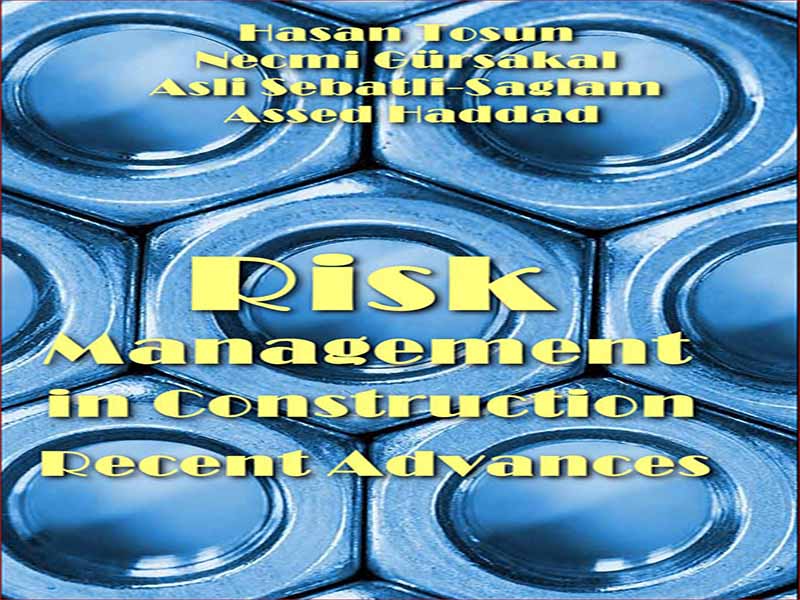- عنوان کتاب: Risk Management in Construction
- نویسنده/انتشارات: Hasan Tosun
- حوزه: مدیریت مخاطرات, ساخت و ساز
- سال انتشار: 2024
- تعداد صفحه: 142
- زبان اصلی: انگلیسی
- نوع فایل: pdf
- حجم فایل: 7.74 مگابایت
در مشخصات اخیر، مقرراتی وجود دارد که در کارگاه های ساختمانی نباید حادثه ای رخ دهد. در واقع ریسک های مربوط به ساخت و ساز دارای ابعاد فرهنگی، اجتماعی و فناوری هستند و با شناسایی مناسب این عوامل می توان ریسک ها را به حداقل رساند. اگرچه هیچ گونه عدم قطعیت اجتماعی و فرهنگی زیادی در کاربردهای انجام شده تاکنون وجود ندارد، اما بعد فناوری، به ویژه استفاده از فناوری های دیجیتال در حداقل سطح بوده است. در حال حاضر، صنعت ساختوساز به بررسی نحوه تعامل سیستمهای فنی-اجتماعی در طول ساخت تمام سازههای مهندسی بزرگ، از جمله سازههای سد، و اثرات آنها بر خطرات در سایتهای ساختمانی میپردازد. اما پس از اتمام ساخت این سازه ها، مدیریت خطرات ناشی از سازه های مربوطه برای محیط زیست موضوعی کاملا مجزا است. این مطالعه بر ریسک کل سازه های سدی که ساخته شده و در مرحله بهره برداری هستند، تمرکز دارد. به دلیل آسیب یا شکست یک سد، عمر پایین دست تحت تأثیر قرار می گیرد و ممکن است خطرات بزرگی رخ دهد. در واقع، بسته به میزان آبی که باید تخلیه شود، بلایای بزرگ ممکن است رخ دهد. برای این منظور ریسک سدها با توجه به نوع، ارتفاع، میزان آبی که ذخیره می کنند، قدمت سد، نیاز تخلیه پایین دست و منطقه آسیب احتمالی تعریف می شود. در روش های جدید ارائه شده، اثرات زمینی موضعی نیز گنجانده شده است. علاوه بر این، این واقعیت که ساختار مربوطه در یک سیستم آبشاری قرار دارد بر درجه خطری که رخ خواهد داد تأثیر می گذارد و ریسک کل سیستم را افزایش می دهد. در این تحقیق پارامترهای موثر بر ریسک کل سازه های سد در مرحله بهره برداری خلاصه شده، روش های مختلف ریسک کل ذکر شده، مجموع ریسک ها برای دو رودخانه مجزا واقع در بزرگترین حوضه آبریز کشور مورد بحث و بررسی قرار گرفته و اقدامات لازم برای انجام آن انجام می شود. بر اساس مدیریت ریسک پیشنهاد می شود. در نهایت، مفهوم جدیدی برای مدیریت ریسک سدها در سیستم آبشاری معرفی شده است.
In recent specifications, there are regulations stating that there should be no accidents on construction sites. In fact, construction-related risks have cultural, social, and technological dimensions, and risks can be minimized by appropriate identification of these factors. Although there are no great social and cultural uncertainties in the applications carried out so far, the technological dimension, especially the use of digital technologies, has been at a minimum level. Currently, the construction industry investigates how social-technical systems interact during the construction of all large engineering structures, including dam structures, and their effects on risks at construction sites. However, after the completion of the construction of these structures, management of the risk posed by the relevant structures for the environment is a very separate issue. This study focuses on the total risk of dam structures that have been constructed and are in the operational stage. Due to damage or failure of a dam, downstream life is affected and huge hazards may occur. In fact, major disasters may occur depending on the amount of water to be discharged. For this purpose, the risk of dams is defined according to their type, height, amount of water they store, age of the dam, downstream evacuation requirement, and potential damage area. In newly presented methods, local ground effects are also included. In addition, the fact that the relevant structure is in a cascade system affects the degree of hazard that will occur and increases the total risk of the system. In this study, the parameters affecting the total risk of dam structures in the operational stage are summarized, various total risk methods are mentioned, the total risks for two separate rivers located in the largest basin of the country are discussed and the necessary measures to be taken on the basis of risk management are suggested. Finally, a new concept is introduced for risk management of dams in the cascade system.
این کتاب را میتوانید از لینک زیر بصورت رایگان دانلود کنید:
Download: Risk Management in Construction



































نظرات کاربران